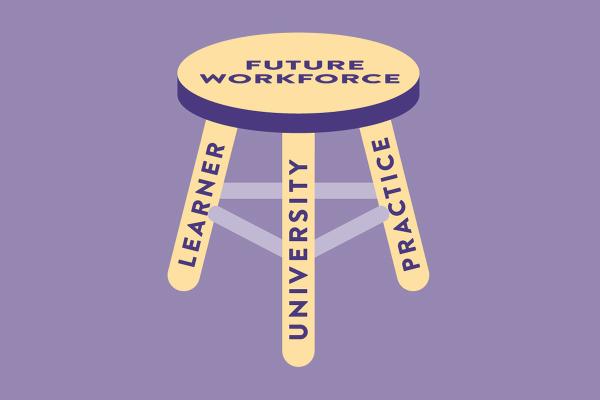The AHP principles of practice-based learning support the development of quality, sustainable placement opportunities for pre-registration physiotherapy learners
We want to make it easier for everyone involved in practice-based learning to come together and create placements that work for all.
In 2022, the CSP worked with the Royal College of Occupational Therapists to develop this set of seven principles. They have acted as a catalyst and framework for conversations across practice and education as well as amongst other professions that we work closely with. It is these conversations that have led to the launch of this updated version co-badged by 10 professional bodies and renamed the 'AHP principles of practice-based learning: working together to support our future workforce'.
The challenges of practice-based learning are common across many AHP professions. By working together with clear and consistent messaging, there is a collective opportunity to better shape and support the provision of quality and sustainable placements.
The same principles can be applied by everyone involved in practice-based learning: students and apprentices; university representatives; practice educators; service leads; business owners and many more.
They offer an opportunity to connect, understand different perspectives and identify areas for joined up working.
Resources to support further exploration of the principles are highlighted below.
1. Practice-based learning opportunities are co-produced

There are lots of people involved in practice-based learning who often have competing priorities. This can make the creation of placements that work for everyone involved feel particularly challenging.
But rather than focus on the differences, let’s instead consider how and where they align. Whether your priority is to recruit a newly registered practitioner into your team or to ensure learners graduate on time as work-ready professionals, we all seek to develop our future workforce.
To address this common goal, we must work together.
The development of the future workforce can be represented as a three-legged stool. Each leg may be separate, but they are all also essential. If one of the legs is missing or knocked away, the common goal simply cannot be achieved.
2. Practice-based learning takes place across all areas, pillars and levels of practice

To better reflect current health and care provision and the evolution of our professions, learners must engage in a diverse range of placements across different sectors, settings and pillars of practice.
This provides more opportunity to see physiotherapy and occupational therapy through a range of different lenses. Whether the placement involves providing rehabilitation, leading a service, researching new insights or supporting learners to grow, the breadth of career possibilities available could inspire and shape our future workforce.
Resources
- Pillar Talk An overview of the four pillars of practice and what they mean to you
- Leadership placements: What are they all about? What to consider when setting up a leadership placement
- The Common Placement Assessment Form (CPAF) This is applicable across all practice-based learning sectors and settings. Find out more about its use including guidance documents and video resources
- Placements - Making it Happen Challenge what's historically been deemed 'too advanced' or 'niche'
- Videos supporting innovation and different forms of placement
- CSP Placement profiles Examples of placements across different pillars and areas of practice to give you inspiration
- Health Education England supportive practice-based learningresources Suite of resources to support innovation in AHP placements – includes guides and toolkits, case studies and videos
- AHP practice-based learning community of practice webinar – Research placements Webinar on research placements to support setting them up
- AHP practice-based learning community of practice webinar – Leadership placements Webinar on leadership placements to support setting them up
3. Practice-based learning environments must be inclusive and welcoming to all

During their formative years it is essential that learners feel a sense of belonging to our professions. We need a strong and diverse workforce, more representative of society, where everyone can belong.
Equity, diversity and belonging is an ongoing lifelong commitment and not an adjunct to our learning, education, clinical practice and services.
Learner welfare and anti-discrimination are a crucial focus for our existing and future work at the CSP and RCOT. It is vital we make sure the experiences of those marginalised due to their protected characteristics, identity, differences and the communities they belong to are positive, equitable and inclusive.
Resources
- CSP Equity, Diversity and Belonging Strategy Launched in October 2021, this was produced in collaboration with diversity networks, members, staff and stakeholders with direct experience of, or insights into, the discrimination and disadvantage faced by members and their patients
- How the CSP is working to oppose racism
- Student wellbeing on placement In this Frontline article, and education lead and practice learning lead explain how they work together to support students' wellbeing while on placement
- Student disability guidance 2.0 Frontline discusses how we can all ensure equity for students with disabilities or long-term conditions
- Into Physiotherapy; welcoming and supporting disabled students Document to promote the creation of positive learning experiences for people with disabilities
4. Practice-based learning uses flexible, appropriate and supportive models of supervision and delivery

There is no such thing as a traditional placement. We practise our professions in so many ways that we cannot have a ‘one size fits all’ approach.
To create high quality, sustainable placements that better meet the needs of the setting, the team and the learners, we should think flexibly in terms of how learners are supervised and how placements are delivered.
Resources
- Peer Learning Frontline article exploring different models of placement supervision
- Health Education England Alternate Supervision Models Video exploring 'alternative' models of supervision
- Exploring the CLiP Model, NHS Employers
5. Practice-based learning is designed with a whole team approach

The whole team has a pivotal role in taking a shared responsibility for practice-based learning and considering the learner as ‘an integral part’ of their team.
Who is ‘the team’? This will look different depending on the service and area of practice. We need to recognise and utilise the wealth of knowledge and skills within our teams, across all professions, scope and level of practice (registered and non-registered practitioners). Everyone should be involved. This in turn allows the learner to be valued.
Whatever the composition of the team, a team approach enables the learner to gain experiential knowledge, skills, behaviours and attitudes by being immersed in a practice environment to prepare for practice.
We need to support everyone in identifying and developing the skills they need to excel in their role, broadening the formal and informal training opportunities available.
6. All those involved in practice education feel valued, respected and recognised within their roles

The work that everyone undertakes to support practice-based learning is essential, and it is important that all those involved feel valued. Without a breadth of high quality placement opportunities there will be no future workforce.
Valuing, recognising and respecting the importance of all those involved in practice education is a shared responsibility, essential to the pre-registration curriculum, to support our current learners, future workforce and to serve our communities.
Resources
- Dear practice education teams... Frontline article thanking practice education teams for their contribution to developing the future workforce and the importance of a sense of wellbeing
- Practice-based learning; supporting, valuing, recognising Frontline article detailing the recommendations of work completed by the CSP in collaboration with Manchester Metropolitan University to support practice educators fulfil their crucial role
- Health Education England – Educator Training Resources Practice educator training resources – must have e-LfH account to access
- Being and becoming an AHP Practice Educator NHS Education for Scotland resources
7. Practice-based learning is evaluated; capturing data to drive improvement and demonstrate impact

Data tells you what you need to know about the value and impact that your placements have. It tells you about what is working well and where there may be frustrations or areas to improve upon. It can enable different approaches to be tested out and help support a case for change.
Once data is collected, think through how it is analysed and how any findings are acted upon.
If dissatisfaction is reported, how is it addressed? How do learners, practice and universities share between each other? If a model of supervision leads to improved staff and learner feedback, how is this showcased?